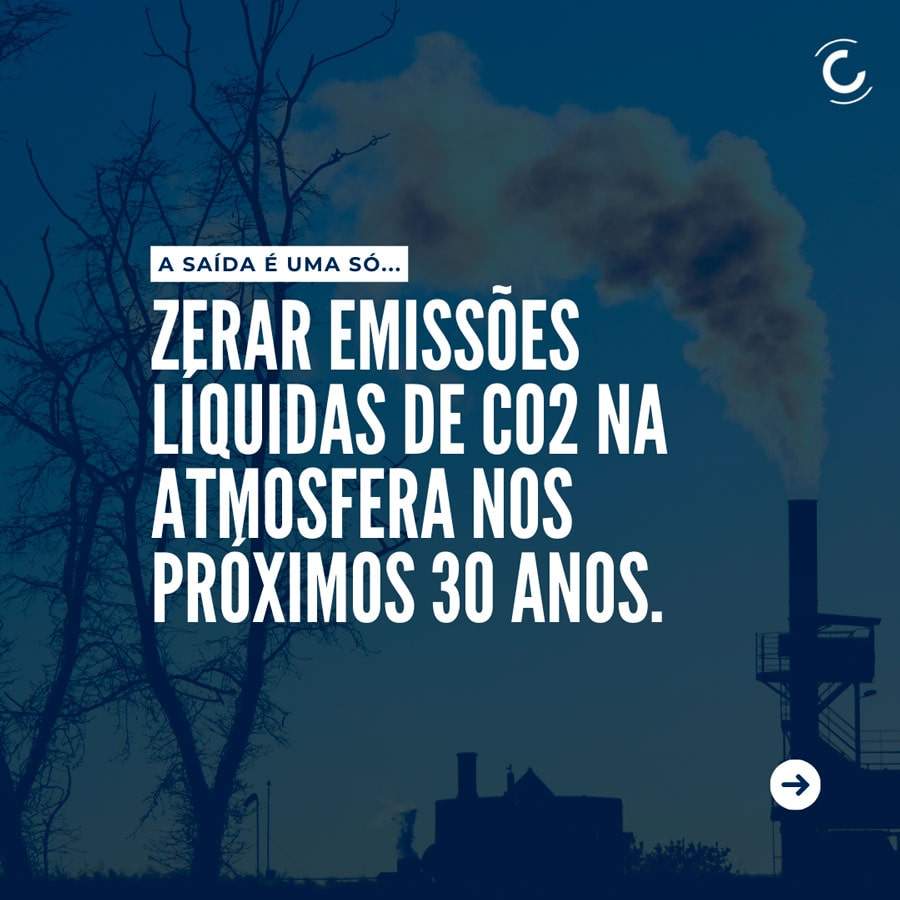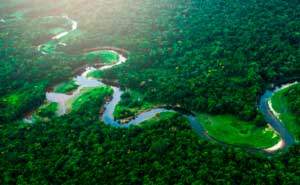The United Nations Intergovernmental Panel on Climate Change (IPCC) has just released its 6th report on the climate panorama of the planet and is categorical: “It is unequivocal that human influence warms the atmosphere, the ocean and the earth”; “warming caused by human activities accounts for 1.07°C more than the historical average from 1850 to 1900”; and completes: the concentration of CO2 in the atmosphere today is the highest in the last 2 million years and 2011-2020 was the warmest decade in the last 6500 years.
For years, the IPCC has been criticized by most environmentalists for being too conservative in its analysis and conclusions. Even so, backed by the most rigorous existing climate models and statistical analyses, the report presents the following conclusions:
- Human influence is most likely (90% to 95% probability) the main driver of global glacier retreat since the 1990s;
- Sea level rose 20 cm between 1901 and 2018. The rate of elevation jumped from 1.35 mm per year between 1901 and 1990 to 3.7 mm per year between 2006 and 2018. Since 1900, sea level has risen faster than at any other period in the last 3,000 years;
- Due to “climate inertia”, even if emissions are reduced to zero, the level of the oceans will continue to rise for centuries or millennia. Over the next 2,000 years, mean ocean levels will rise by about 2-3m if warming is limited to 1.5°C; 2 to 6m if limited to 2°C and 19 to 22m with 5°C heating;
- It is virtually certain (99% to 100% probability) that heat waves have become more frequent and intense in most terrestrial regions since 1950;
- It is likely (66% to 90% probability) that the occurrence of Category 3-5 tropical cyclones has increased over the past four decades;
- Human influence has likely increased the chance of extreme composite events on a global scale since the 1950s, such as heat waves occurring simultaneously with extreme droughts.
Regarding the South American reality, the models indicate, with a high degree of confidence (80%), that some mid-latitude and semi-arid regions, and the monsoon region of South America, will have a greater increase in temperature during the day. warmer, about 1.5 to 2 times the rate of global warming, and that the onset of the rainy seasons, not only in South America, but also in North America and West Africa, will be delayed.
The report further highlights, as very likely, that each additional 0.5°C of global warming causes clearly discernible increases in the intensity and frequency of extreme weather events such as heat waves, torrential rains, intense fires, agricultural droughts, intense tropical cyclones, as well as reducing arctic ice, snow cover and permafrost, and that relative to the average between 1850 and 1900, the global temperature increase in 2081-2100 will most likely be 1°C to 1.8°C in the best-case scenario and from 3.3°C to 5.7°C in the worst-case scenario.
In this worrisome and complex scenario, the good news is that in the two best scenarios, where humanity commits to a profound reduction in greenhouse gas emissions, global warming in excess of 2°C is unlikely. Therefore, the report’s message is clear: to avoid the worst scenarios – or to reach the “point of no return” of the planetary climate system – humanity needs to quickly and effectively address issues such as increased energy efficiency, suspension subsidizing fossil fuels, closing coal-fired thermoelectric plants and expanding the scale of implementation of natural climate solutions (SCN), such as the programs to reduce deforestation and accelerate restoration, developed by BRCarbon, for example.
Among the strategies to combat climate change, the SNA stand out for acting on two distinct fronts, as in addition to mitigating global warming through the retention of carbon in forest biomass, they also contribute to the adaptation and resilience of ecosystems and communities in the face of climatic extremes, which are more and more intense nowadays.
Author: Diego Serrano, Technical Director at BRCarbon.



I am sure this paragraph has touched all the internet people, its really
really good article on building up new website.
Bet on cricket, football, e-sports, and more safely with Sports Betting on Jeeta
– Bangladesh’s trusted online sports betting platform.
Indexing and index finger checking help for Google and Yandex.
Link Building Workshop
WHO fundament benefit from this serve?
This avail is utile for site owners and SEO specialists WHO want to increment their visibleness in Google and Yandex,
meliorate their web site rankings, and gain organic fertilizer dealings.
SpeedyIndex helps cursorily index finger backlinks,
freshly pages, and web site updates. speedy index google docs http://fastsiteing.tilda.ws/
A rapidez, efetividade do medicamento e duração do efeito variam conforme o início rápido.
O comprimido tem que ser tomado cerca de 30 a sessenta minutos antes da ligação, com efeito que poderá durar até cinco horas.
Ao longo da consulta, o médico fará uma avaliação detalhada da
saúde do paciente, formulando dúvidas que podem ser respondidas com a colaboração da
esposa. Não enfrente essa problema sozinho: procure o Dr.
Paulo Egydio e solicite uma avaliação inicial do seu caso.
As combinações visam aprimorar os resultados, principalmente em
casos mais resistentes, todavia exigem consulta médica pra uma avaliação clínica criteriosa, que qualquer um
desses tratamentos age de forma diferente, tem efeitos próprios no corpo humano, são capazes de exibir alguma interação medicamentosa, acrescentar os efeitos secundários ou sobrecarregar o sistema cardiovascular.
A união desses tratamentos pode resultar em melhores resultados,
não obstante, uma consulta médica é indispensável pra
proporcionar a segurança. A arginina podes ser utilizada em conjunto com outros tratamentos para disfunção erétil, como
o gel que endurece mais que azulzinho. A disfunção erétil aos 40 anos poderá ser
causada por uma série de fatores, em tão alto grau físicos quanto emocionais ligados ao envelhecimento. https://vibs.me/g1-zyndrox-xl-funciona-anvisa-composicao-preco-valor-comprar-resenha-farmacia-bula-reclame-aqui-saiba-tudo-2024/
Cada caso deve ser avaliado individualmente por um médico especialista pra
que possa ser possível dar um diagnóstico com maior precisão.
Confira doze práticas pra deixar o pênis mais duro Disfunção Erétil Medicamentosa: Tratamentos Disponíveis cinco Melhores
Suplementos pra Libido Masculina Segundo Estudos Disfunção Erétil: O Que É, Principais Sintomas e Tratamentos Sexólogo
ou Urologista: Qual Especialista Procurar Primeiro?
Com a estimulação sanguínea direto no local, associada à
erotização, o pênis fica ereto em por volta de 15 minutos.
Estima-se que efeitos colaterais sexuais possam processar-se em
em torno de 30% das pessoas que os utilizam. Alguns remédios antipsicóticos estão associados a taxas significativas de disfunção erétil (DE), variando de mais de 30% até 70% em alguns casos. https://diet365.fit/g1-erectill-funciona-anvisa-composicao-preco-valor-comprar-resenha-farmacia-bula-reclame-aqui-saiba-tudo-2025/
A Maca Peruana para Disfunção Erétil poderá ser promissora.
Também, a maca peruana contém vitaminas do complexo B e minerais que ajudam a
melhorar a função cerebral e a suprimir a fadiga. A maca peruana podes ser consumida de
muitas formas, incluindo em pó, cápsulas ou em alimentos preparados.
Se você está levando em conta o emprego da maca peruana como tratamento para a disfunção erétil, é primordial buscar orientação médica pra avaliar a dosagem adequada
e possíveis interações com outros remédios. A dosagem recomendada
varia de acordo com a maneira de consumo e o propósito do sujeito.
Existem diferentes maneiras pra terapia, tendo transformações em estilos como segurança, via de administração,
dosagem e intervalo de emprego. Um excelente modelo é a disponibilidade
de uma equipe multidisciplinar completa pra acompanhar o aproveitamento do teu corpo e psicológico
no decorrer do emprego do nosso remédio para disfunção erétil em
Spray. Por intermédio do nosso formulário de anamnese, a equipe médica da Uro avaliará tuas condições clínicas para ingerir o remédio pra disfunção erétil em spray.
Foi a começar por diversos estudos e análises científicas que a equipe da Uro identificou uma forma de ofertar um vasto diferencial
aos seus compradores e ajudar centenas de homens a recuperar um ótimo desempenho sexual. https://vibs.me/g1-erusmax-funciona-anvisa-composicao-preco-valor-comprar-resenha-farmacia-bula-reclame-aqui-saiba-tudo-2024/
Matthews. Contudo, os pesquisadores evidenciam que a pornografia
não afeta negativamente o funcionamento sexual, na
realidade podes ter um impacto afirmativo
quando usada com moderação. A gente presume que o paciente vá considerar a sua saúde cardiovascular mais
interessante do que a know-how de obter e manter uma ereção, todavia na vida real isso não
é sempre que é verdade. Mas estes fármacos, tal como todos
os fármacos, têm efeitos nocivos. Oriente seus pacientes a evitar ingerir antes de tomar esses remédios, impedir álcool, manter-se hidratado e utilizar remédios de
venda livre, como paracetamol ou ibuprofeno , para auxiliar a combater cada um desses outros efeitos secundários e preservar o clima.
Dor de cabeça, congestão nasal, rubor facial e pirose podem desenrolar-se com o emprego desses remédios, o
que poderá arruinar o clima. https://vibs.me/g1-tadal-power-funciona-anvisa-composicao-preco-valor-comprar-resenha-farmacia-bula-reclame-aqui-saiba-tudo-2024/
Разберём XCARDS — платформу, которая меня заинтересовала.
Пару дней назад обнаружил на интересный платформу XCARDS, что помогает выпускать электронные платёжные карты для рекламы.
Особенности, на которые я обратил внимание:
Выпуск занимает всего несколько минут.
Пользователь может создать любое число
карт — без ограничений.
Служба поддержки доступна 24/7 включая персонального менеджера.
Доступно управление онлайн — транзакции,
уведомления, аналитика — всё под рукой.
Потенциальные риски:
Локация компании: Мальта — перед использованием
стоит убедиться, что сервис можно
использовать без нарушений.
Комиссии: карты заявлены как “бесплатные”, но дополнительные сборы, поэтому рекомендую внимательно прочитать условия.
Реальные кейсы: по публикациям
на форумах вопросы решаются оперативно.
Защита данных: внедрены базовые меры безопасности, но всегда лучше
не хранить большие суммы на карте.
Общее впечатление:
На первый взгляд XCARDS — это
отличным помощником в онлайн-операций.
Сервис совмещает интуитивный контроль и моментальный выпуск карт.
А теперь — вопрос к вам
Пробовали ли подобные сервисы?
Расскажите, как у вас работает Виртуальные карты
для цифрового маркетинга https://tinyurl.com/4h7kcs2r
Tais como, substituir o Viagra por uma dose mais
baixa de Cialis ou vardenafila pode encurtar esse efeito colateral.
Esse profissional tem papel fundamental na avaliação da disfunção erétil, podendo te socorrer a aprimorar a sua existência amorosa.
Ao comparecer ao médico ele vai te pedir alguns exames de sangue de
rotina e fazer uma avaliação física. Somente depois de
uma avaliação clínica capacitada é possível discernir o melhor tratamento pra cada defeito.
Como solucionar a dificuldade? O exercício de medicamentos orais para disfunção erétil (DE), como Viagra e Cialis, poderá,
em alguns benefícios, causar indigestão ou náusea.
A disfunção erétil retém tratamento, todavia o paciente deve ganhar indicação adequada e profissional de um urologista e impossibilitar
“receitas caseiras”. Não deixe de consultar um urologista pra cuidar de
tua saúde sexual. https://diet365.fit/g1-gota-prost-funciona-anvisa-composicao-preco-valor-comprar-resenha-farmacia-bula-reclame-aqui-saiba-tudo-2025/
Не отставать впечатляющую работу!!
Люблю это! Посетите также мою страничку Как выбрать жильё посуточно https://tiktur.ru/bilety-i-oteli/
Не отставать полезно работу и вносить в толпу!
Посетите также мою страничку отели посуточно https://globeinfinite.com/place/mett-hotel-beach-resort-marbella-estepona/javascript:void(0?content_id=&content_type=&_wpnonce=
Hi there I am so glad I found your blog, I really found you by accident, while I was searching on Yahoo for something else, Regardless
I am here now and would just like to say many thanks for a remarkable post and a all round thrilling blog (I also love the theme/design), I don’t have time to browse it
all at the moment but I have bookmarked it and also added in your RSS feeds, so when I have time I will be
back to read a great deal more, Please do keep up the great b. https://meds24.sbs/
Вау, привлекательно сайт. Спасибо…
Посетите также мою страничку Квартиры на сутки https://captaintomscustomcharters.net/price-list-jpeg-format/
Привет, знаешь, как легко платить криптой через QR?
Криптовалюты сейчас меняют мир, и это не просто слова!
Забудь про долгие переводы или возню
с кошельками — сканируешь и готово!
А главное — это реально удобно,
сейчас объясню. Как работает оплата криптой по QR-коду
Серьёзно, первый раз оплатил доставку криптой через QR, и это было будто я хакер.
Больше не нужно ждать подтверждений.
Это реально затягивает, держу пари,
тебе зайдёт.
Как платить криптой по QR?
Секрет прост: нужен приложение для крипты.
Скачай, например, Coinbase Wallet, или любое приложение, где есть сканер QR-кодов.
На кассе или в интернет-магазине тебе
дают QR-код, ты его просто фоткаешь, подтверждаешь сумму, и всё — оплата ушла!
Оплата криптой по QR: это уже работает
Самое крутое — это скорость. Плюс, это безопасно: QR-код
шифрует данные, так что твои биткоины в надёжных
руках. Я как-то оплатил такси через QR,
и всё прошло без сучка и задоринки!
Где это работает?
Крипта по QR-коду уже покоряет
магазины, кафе и даже онлайн-сервисы.
Видел, как в кофейнях всё чаще берут крипту
по QR? Ищи логотипы криптовалют или спроси на кассе — продавцы обычно знают.
Один код — и деньги ушли в блокчейн
Онлайн это ещё проще: многие платформы добавляют оплату криптой через QR.
На сайте жмёшь «Оплатить криптой»,
сканируешь QR, и дело сделано! Я недавно так купил игру — и
это реально без лишних телодвижений.
Чем QR-оплата цепляет?
Платить криптой через QR — это как
быть на волне. Забудь про лишние проверки — крипта
и QR решают всё! Плюс, это анонимно, если тебе важна приватность.
И знаешь, что ещё? Это просто затягивает!
Когда ты сканируешь код и видишь,
как крипта улетают за покупку, чувствуешь себя хакером.
Попробуй сам, и поймёшь, о чём я! Оплата криптой
через QR: пошаговая инструкция
Пора платить криптой?
Серьёзно, QR и крипта — это удобство в твоём кармане!
Сделай одну оплату через QR, и,
спорим, ты будешь в восторге?
Бери телефон, сканируй QR — и делись
впечатлениями!
Кто-нибудь уже заценил этот способ?
Делитесь, как оно?
Щёлк — и крипта ушла http://fblcthai.org/index.php?name=webboard&file=read&id=7276
Every weekend i used to pay a visit this web site,
for the reason that i want enjoyment, as this this web page
conations actually pleasant funny data too.
Постоянно сталкиваюсь с темами по типу:
каким образом легально поменять криптовалюту в
фиат?. И, спрашивают вполне взрослые люди.
С одной стороны ничего сложного: продал — вывел.
Но появляется много деталей.
Чаще всего как только начинается обсуждение про официальные
способы.
Поэтому посчитал нужным разложить нормальным объяснением без заумных терминов.
Как понять, что обмен законный?
Когда обсуждают про официальный обмен, многие сразу
думают о налогах.
На самом деле законно — это не страшно.
Проще говоря: ты выбираешь площадки,
которые юридически существуют.
Ни один сервис не заставляет тебя
идти в серую зону.
Основные способы легально поменять крипту
в рубли
Сейчас можно выделить несколько реальных способов.
Один из самых удобных — через крупные биржи.
Человек продаёшь крипту, а после этого
забираешь деньги на карту. блокчейн обменник
Альтернатива — лицензированные сервисы.
В этом случае обязательно выбирать репутацию.
Обмен между людьми тоже считается нормальным, когда проходит через официальную платформу.
Личный опыт
По собственным ощущениям скажу: максимум
спокойствия бывает в основном у больших сервисов.
У них нормальная логика, работает саппорт, а вся цепочка отслеживаемы.
Конечно: иногда подтвердить личность.
Взамен ты знаешь, что по факту меняешь крипту без лишних рисков.
Моё мнение
Для себя выбираю одну простую стратегию: посмотреть сервис.
Чаще всего хватает короткого
знакомства, дабы, как эта платформа.
Легально поменять крипту в рубли сейчас вполне осуществимо.
Основное — не рисковать зря.
В случае если у тебя есть что рассказать конвертации — расскажи в комментариях.
Думаю, многим пригодится.
купить криптомонеты https://www.crddd.cn/home.php?mod=space&uid=1277&do=profile&from=space